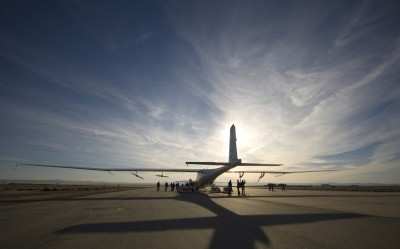Program Proceeding Toward Flight Test Phase
The first aircraft developed under the Global Observer Joint
Capability Technology Demonstration (JCTD) program has successfully
completed key ground tests in preparation for flight testing,
AeroVironment, the company developing the UAS, said Wednesday. The
joint Department of Defense, NASA and AV team successfully
performed ground vibration, structural and taxi tests at Edwards
Air Force Base (EAFB) in California. AV developed and fabricated
Aircraft 1 in its dedicated manufacturing facility located in
Southern California and shipped it to EAFB in December 2009.

AV is developing the Global Observer unmanned aircraft system
(UAS) to be the first to provide robust, cost-effective and
persistent communications and surveillance over any location. Six
U.S. government agencies have provided more than $120 million in
funding for the JCTD program.
“Global Observer is designed to perform above and beyond
the capabilities of any other existing aircraft. The unique benefit
of this truly unblinking eye will be its ability to watch, listen
and relay communications signals flexibly, affordably and without
interruption,” said Tim Conver, AV’s chairman and chief
executive officer. “The need for affordable and seamless
persistence is great, and we look forward to demonstrating this
important capability during the final phase of the Global Observer
JCTD program.”
Each aircraft in a Global Observer system is designed to fly at
an altitude of between 55,000 and 65,000 feet for 5 to 7 days. In
addition to flying above weather and above other conventional
airplanes, operation in this altitude range means that sensor on
the aircraft will be able to view a circular area on the surface of
the earth up to 600 miles in diameter, equivalent to more than
280,000 square miles of coverage. Equipped with payloads that are
readily available today, two Global Observer aircraft would
alternate coverage over any location on the globe every 5 to 7
days, making this the first solution to provide customers with
practical, seamless coverage, wherever and whenever required.
 The joint Department of Defense, NASA and AV team based at EAFB
completed aircraft weight and balance measurements and conducted a
series of Ground Vibration and Structural Modes Interaction Tests
in February. During March and April the team performed aircraft
system tests to validate the aircraft hardware and software
readiness, and to support ground and flight crew training in
preparation for the initial flight series. Most recently, taxi
tests were conducted to confirm autonomous propulsion, data link
operation, steering and braking. A final Flight Readiness Review
will be conducted to formally review and approve the initiation of
flight testing. Initial flight testing will consist of low-altitude
battery-powered flights at EAFB to evaluate the aircraft's
airworthiness and handling qualities.
The joint Department of Defense, NASA and AV team based at EAFB
completed aircraft weight and balance measurements and conducted a
series of Ground Vibration and Structural Modes Interaction Tests
in February. During March and April the team performed aircraft
system tests to validate the aircraft hardware and software
readiness, and to support ground and flight crew training in
preparation for the initial flight series. Most recently, taxi
tests were conducted to confirm autonomous propulsion, data link
operation, steering and braking. A final Flight Readiness Review
will be conducted to formally review and approve the initiation of
flight testing. Initial flight testing will consist of low-altitude
battery-powered flights at EAFB to evaluate the aircraft's
airworthiness and handling qualities.
Communications relay and intelligence, surveillance and
reconnaissance (ISR) payloads are being prepared for installation
into the aircraft. Once development flight tests have been
completed, payloads will be installed and joint operational utility
flight demonstrations will be performed at EAFB.
Global Observer is designed to address an urgent national
security need for a persistent stratospheric platform and to offer
a means to satisfy numerous high value civil and commercial
applications. The system is intended to provide mission
capabilities that include robust observation over areas with little
or no existing coverage, persistent communications relay, the
ability to relocate the system as required by theater commanders,
dedicated communications support to other UAS and tactical
on-station weather monitoring and data support. Final assembly of
Aircraft 2 is proceeding at the AV Global Observer manufacturing
facility.
 Aero-News: Quote of the Day (04.17.24)
Aero-News: Quote of the Day (04.17.24) ANN's Daily Aero-Linx (04.17.24)
ANN's Daily Aero-Linx (04.17.24) Airborne-Flight Training 04.17.24: Feds Need Controllers, Spirit Delay, Redbird
Airborne-Flight Training 04.17.24: Feds Need Controllers, Spirit Delay, Redbird Airborne 04.16.24: RV Update, Affordable Flying Expo, Diamond Lil
Airborne 04.16.24: RV Update, Affordable Flying Expo, Diamond Lil Airborne 04.11.24: SnF24!, King's 50th, Top Rudder, Aileronics
Airborne 04.11.24: SnF24!, King's 50th, Top Rudder, Aileronics

 The joint Department of Defense, NASA and AV team based at EAFB
completed aircraft weight and balance measurements and conducted a
series of Ground Vibration and Structural Modes Interaction Tests
in February. During March and April the team performed aircraft
system tests to validate the aircraft hardware and software
readiness, and to support ground and flight crew training in
preparation for the initial flight series. Most recently, taxi
tests were conducted to confirm autonomous propulsion, data link
operation, steering and braking. A final Flight Readiness Review
will be conducted to formally review and approve the initiation of
flight testing. Initial flight testing will consist of low-altitude
battery-powered flights at EAFB to evaluate the aircraft's
airworthiness and handling qualities.
The joint Department of Defense, NASA and AV team based at EAFB
completed aircraft weight and balance measurements and conducted a
series of Ground Vibration and Structural Modes Interaction Tests
in February. During March and April the team performed aircraft
system tests to validate the aircraft hardware and software
readiness, and to support ground and flight crew training in
preparation for the initial flight series. Most recently, taxi
tests were conducted to confirm autonomous propulsion, data link
operation, steering and braking. A final Flight Readiness Review
will be conducted to formally review and approve the initiation of
flight testing. Initial flight testing will consist of low-altitude
battery-powered flights at EAFB to evaluate the aircraft's
airworthiness and handling qualities.

